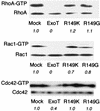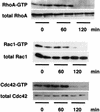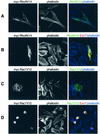Pseudomonas aeruginosa ExoT acts in vivo as a GTPase-activating protein for RhoA, Rac1, and Cdc42
- PMID: 11895987
- PMCID: PMC127837
- DOI: 10.1128/IAI.70.4.2198-2205.2002
Pseudomonas aeruginosa ExoT acts in vivo as a GTPase-activating protein for RhoA, Rac1, and Cdc42
Abstract
The Pseudomonas aeruginosa protein ExoT is a bacterial GTPase-activating protein (GAP) that has in vitro activity toward Rho, Rac, and Cdc42 GTPases. Expression of ExoT both inhibits the internalization of strain PA103 by macrophages and epithelial cells and is associated with morphological changes (cell rounding and detachment) of infected cells. We find that expression of ExoT leads to the loss of GTP-bound RhoA, Rac1, and Cdc42 in transfected HeLa cells, demonstrating that ExoT has GAP activity in vivo toward all three GTPases. GAP activity is absolutely dependent on the presence of arginine at position 149 but is not affected by whether ExoT is expressed in the absence or presence of other P. aeruginosa type III secreted proteins. We also demonstrate that expression of ExoT in epithelial cells is sufficient to cause stress fiber disassembly by means of ExoT's GAP activity toward RhoA.
Figures





Similar articles
-
In vivo rho GTPase-activating protein activity of Pseudomonas aeruginosa cytotoxin ExoS.Infect Immun. 2002 Jan;70(1):360-7. doi: 10.1128/IAI.70.1.360-367.2002. Infect Immun. 2002. PMID: 11748202 Free PMC article.
-
Rho GTPase activity modulates Pseudomonas aeruginosa internalization by epithelial cells.Cell Microbiol. 2001 Feb;3(2):85-98. doi: 10.1046/j.1462-5822.2001.00091.x. Cell Microbiol. 2001. PMID: 11207623
-
Pseudomonas aeruginosa ExoT is a Rho GTPase-activating protein.Infect Immun. 2000 Oct;68(10):6066-8. doi: 10.1128/IAI.68.10.6066-6068.2000. Infect Immun. 2000. PMID: 10992524 Free PMC article.
-
Pseudomonas aeruginosa ExoS and ExoT.Rev Physiol Biochem Pharmacol. 2004;152:79-92. doi: 10.1007/s10254-004-0031-7. Epub 2004 Aug 24. Rev Physiol Biochem Pharmacol. 2004. PMID: 15375697 Review.
-
FilGAP and its close relatives: a mediator of Rho-Rac antagonism that regulates cell morphology and migration.Biochem J. 2013 Jul 1;453(1):17-25. doi: 10.1042/BJ20130290. Biochem J. 2013. PMID: 23763313 Review.
Cited by
-
Pseudomonas aeruginosa ExoT induces G1 cell cycle arrest in melanoma cells.Cell Microbiol. 2021 Aug;23(8):e13339. doi: 10.1111/cmi.13339. Epub 2021 Apr 14. Cell Microbiol. 2021. PMID: 33821556 Free PMC article.
-
Molecular Mechanisms Involved in Pseudomonas aeruginosa Bacteremia.Adv Exp Med Biol. 2022;1386:325-345. doi: 10.1007/978-3-031-08491-1_12. Adv Exp Med Biol. 2022. PMID: 36258078 Review.
-
ADP-Ribosylargininyl reaction of cholix toxin is mediated through diffusible intermediates.BMC Biochem. 2014 Dec 11;15:26. doi: 10.1186/s12858-014-0026-1. BMC Biochem. 2014. PMID: 25494717 Free PMC article.
-
Pseudomonas aeruginosa Transmigrates at Epithelial Cell-Cell Junctions, Exploiting Sites of Cell Division and Senescent Cell Extrusion.PLoS Pathog. 2016 Jan 4;12(1):e1005377. doi: 10.1371/journal.ppat.1005377. eCollection 2016 Jan. PLoS Pathog. 2016. PMID: 26727615 Free PMC article.
-
Pseudomonas aeruginosa ExoT Induces Mitochondrial Apoptosis in Target Host Cells in a Manner That Depends on Its GTPase-activating Protein (GAP) Domain Activity.J Biol Chem. 2015 Nov 27;290(48):29063-73. doi: 10.1074/jbc.M115.689950. Epub 2015 Oct 8. J Biol Chem. 2015. PMID: 26451042 Free PMC article.
References
-
- Andor, A., K. Trulzsch, M. Essler, A. Roggenkamp, A. Wiedemann, J. Heesemann, and M. Aepfelbacher. 2001. YopE of Yersinia, a GAP for Rho GTPases, selectively modulates Rac-dependent actin structures in endothelial cells. Cell. Microbiol. 3:301-310. - PubMed
-
- Bagrodia, S., S. J. Taylor, K. A. Jordon, L. Van Aelst, and R. A. Cerione. 1998. A novel regulator of p21-activated kinases. J. Biol. Chem. 273:23633-23636. - PubMed
-
- Black, D. B., and J. B. Bliska. 2000. The RhoGAP activity of the Yersinia cytotoxin YopE is required for antiphagocytic function and virulence. Mol. Microbiol. 37:515-527. - PubMed
-
- Bliska, J. B. 2000. Yop effectors of Yersinia spp. and actin rearrangements. Trends Microbiol. 8:205-208. - PubMed
Publication types
MeSH terms
Substances
Grants and funding
LinkOut - more resources
Full Text Sources
Research Materials
Miscellaneous

